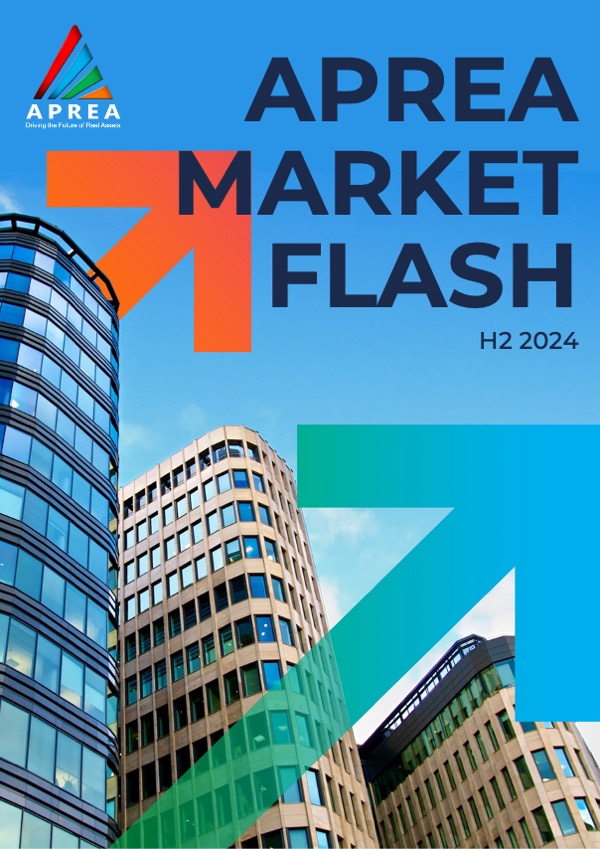APREA Market Flash H2 2024

As we look ahead into the second half of 2024, the investment landscape in the Asia Pacific presents a wealth of opportunities across various sectors.
We have asked industry leaders and experts to share their views and what we have found out is that despite uncertainties and the delayed interest rate cuts by the US Federal Reserve, the APAC region remains resilient and promising. The diverse economies within this region, from the technological hubs of Japan and Singapore to the growing markets of India and Southeast Asia, are poised for significant growth and transformation.
In particular, the industrial and logistics sectors are experiencing robust demand, driven by the rapid expansion of e-commerce and digital infrastructure. Similarly, specialized living sectors such as build-to-rent, student housing, and senior living continue to attract strong investor interest, supported by favorable demographic trends and changing societal norms.
Sustainability and innovation are at the forefront of real assets development in APAC. The push towards ESG standards is transforming the market, with green building practices and renewable energy solutions becoming integral to new developments. Furthermore, technological advancements in smart building technologies and PropTech innovations are enhancing operational efficiencies and creating new value propositions for investors.
As our latest issue of APREA Market Flash shows, the Asia Pacific’s strong fundamentals and forward-looking growth prospects make it an attractive destination for investment, promising stable returns and long-term value creation.
Sigrid ZialcitaCEO
APREA

Aashiesh Agarwaal
Senior Vice President - Research and Investment Advisory, Capital Markets
ANAROCK Capital Advisors Pvt Ltd

Andy Lim
Founder, The Land Managers
Group CEO, JL Family Office

Aurelia Lee
Chief Operating Officer - Investment & Asset Management
Sime Darby Property

Badal Yagnik
CEO
Colliers India

Christian Bernasconi
Co-Founder, Managing Director
B&I Capital

Greg Hyland
Head of Capital Markets, Asia Pacific
CBRE

James Ong
Chief Strategy Officer
Tsao Pao Chee (TPC)

James Young
Head of Investor Services, EMEA & APAC
Cushman & Wakefield

Jason Lee
Chief Investment Officer, Senior Portfolio Manager, Head of Private Equity Asia
AEW Asia

Jeremy Choy
Managing Director, Funds Management, APAC Value Add
CapitaLand Investment

Joachim Kehr
Portfolio & Regional Head, Asia-Pacific
CenterSquare Investment Management Asia Pacific

Junnosuke Shinkawa
Chief Portfolio Manager, Global Listed Real Estate
Sumitomo Mitsui DS Asset Management Company, Limited

Kong Ling Yi
Managing Director and Chief Investment Officer
Shenzhen Capital Real Estate Company

Momota Minoru
CEO
Mercuria (Thailand) Co., Ltd.

Ondrej Sychrovsky
Member of the Board of Directors
ZDR Investments SG VCC

Radha Dhir
CEO and Country Head, India
JLL

Rick Santos
Chairman and Chief Executive Officer
Santos Knight Frank

Sridhar Nagarajan
Regional CEO - Asia, Middle-East and Africa
IQ-EQ
What are your expectations for investment opportunities in APAC for the rest of the year?
The Indian economy has been a beneficiary of a slew of measures introduced by successive governments. Of particular relevance has been the implementation of GST, insolvency laws, and the Make in India initiative, with the landmark PLI scheme which has given a significant boost to the economy.
Mirroring the economy is the Indian real estate, which is in a sweet spot with demand firing across all broad sub-sectors. We believe the up cycle is firmly entrenched and likely to continue in the foreseeable future.
Accordingly, India real estate would continue to present attractive investment opportunities in residential, commercial and warehousing sub-segments.
Within residential sub-segment, we anticipate an increase in large ticket investments in mid to premium housing segment, and in plotted developments. In the commercial and warehousing sub- segment, we anticipate sustained interest in greenfield and operational assets, especially with expected softening of interest rates.
The increase in investment opportunities is co-incident with increase in risk appetite by investors, which augurs well for the overall investment climate within Indian real estate.
Are you expecting more repricing/distressed opportunities to emerge?
With the industry enjoying favourable tailwinds, we are not anticipating meaningful fresh stress in the system. However, erstwhile stressed assets where resolution looked difficult are seeing improved viability due to improved asset pricing and cash flow visibility. Furthermore, owners of stressed assets are increasingly inclined to redirect management effort from recoveries through litigation and instead negotiate settlements with promoters, so that the freed-up management bandwidth can be used to drive growth instead. Hence, we anticipate increased opportunities of promoter / settlement financing.
Aashiesh Agarwaal
Senior Vice President - Research and Investment Advisory, Capital Markets
ANAROCK Capital Advisors Pvt Ltd
In view of delays to much-anticipated interest rate cuts by the US Federal Reserve, what kind of opportunities are you considering? How has this changed your portfolio strategy? Which countriesand sectors in APAC are you finding most resilient?
Contrary to most market commentators, we have always held the view and worked on the basis that there will be minimal or no interest rate cuts in 2024. In fact, given the strength of the US economy and its sticky levels of inflation, the chances of a small hike at the end or start of next year is no longer impossible as well.
As such, we have thus taken a defensive view on our portfolio. Since early 2022 we begun deleveraging our assets and focused on executing our value-add plans to each of our strategies to moderate the effects of valuation resets in each sector.
In the West, real estate values have already begun its reset cycle and we do expect APEC to follow suit in the coming months as well. However, we do still see value in value-add strategies in developed markets which focuses on key macroeconomic themes like living and supply chain dynamics. We think these value-add strategies should hold well in the coming months. In particular, Singapore, Australia and Japan are interesting markets for us.
What themes have proven relevant to your overarching strategy in H1 2024, and how do you plan to build on these in the second half of the year?
As a firm, at the start of 2024 we had operated on the basis that that there will be minimal or no interest rate cuts in 2024. In rationale is simple, even if a rate cut occurred during the course of the year, it would be easier to adjust to a rate cut, then an unexpected rate hike. As such, our thesis at the start of 2024 is playing out and in H2 2024 we will continue to focus on deleveraging where possible and focusing on value-add strategies in the build-to-rent and logistics space in APAC.
Andy Lim
Founder, The Land Managers
Group CEO, JL Family Office
What are your expectations for investment opportunities in APAC for the rest of the year? Are you expecting more repricing/distressed opportunities to emerge?
Which emerging technology, sustainability, and innovation trends are you most excited about and how will they impact the real assets industry?
We are observing a measured approach to real estate investments in the APAC region due to the expectation that interest rates will remain elevated in the near term. Market consensus suggests that the US Federal Reserve may not begin lowering rates until the end of 2024 or later. As the current interest rate hike cycle has paused for most markets, we expect to see the beginning of a new real estate investment cycle marked by an increase in investment activity on clarity over the current asset repricing cycle, gradual easing of interest rates and yield expansion.
In a market with tight yield spreads, investors are looking for opportunities that can offer higher returns, especially in value-add projects. They are also prioritizing core real estate in top-tier markets due to the stable cash flow these properties provide. Regionally, we expect the industrial and logistics sectors to remain popular for investments in 2024. Additionally, there is increasing interest in specialised living sectors such as build-to-rent/build-to-sell and student housing.
Malaysia has seen significant investments in data centres and electronics manufacturing, driven by both local and international factors. The demand for electronics manufacturing facilities has surged due to global supply chain changes, prompting multinationals to initiate large-scale developments in northern peninsular Malaysia.
The forecast for data centre capacity in Malaysia has risen exponentially thanks to the increasing need for AI and machine learning, Malaysia’s strategic location in ASEAN, and affordable land and electricity with potential for renewable energy supply. With the government's commitment to the power supply and new sub-sea cable landing stations, data centres are set to become a major asset class in Malaysia.
We are witnessing a strong push towards ESG (Environmental, Social, and Governance) standards. Many existing buildings are being retrofitted to comply with these standards, especially as multinational companies aim for net zero emissions by 2030. Green spaces and ESG-compliant properties are expected to be a main stay in occupier demand criteria and investment assets.
Expanding on the focus of sustainability, the need for sustainable green energy in the industrial and logistics sectors, as well as data centres, has driven demand for renewable energy such as solar. To this end, the Malaysian government, via its Net Energy Transition Roadmap (NETR), has outlined the country's ambition to achieve net zero by 2050.
Aurelia Lee
Chief Operating Officer - Investment & Asset Management
Sime Darby Property
Which emerging technology, sustainability, and innovation trends are you most excited about and how will they impact the real assets industry?
The Indian real estate sector is experiencing transformative changes driven by innovative technologies and sustainability trends that are set to drive efficiencies, and enhance the overall value proposition for real estate assets. Among the most exciting trends are the adoption of smart building technologies, the rise of Proptech innovations, and the increasing emphasis on green practices. Developers are increasingly prioritizing these elements in their greenfield real estate developments and, while retrofitting their existing inventory. India offers huge opportunity in the space, with almost 300-350 million sq ft of Grade A office stock across the top six cities holding potential to get refurbished/retrofitted and become E-compliant. These E-upgradations are likely to fetch 5-10% higher rental premium, enhancing property valuations and marketability, and are likely to receive more traction from occupiers.
Smart Building Technologies - Smart building technologies, incorporating IoT and advanced automation systems, are helping property managers optimize building performance and maintenance schedules, through real time monitoring of various building systems. Further, advancements in construction technology, such as Building Information Modeling (BIM), 3D printing, and modular construction, are driving significant efficiencies in design & development. BIM allows for detailed 3D modelling and collaborative project planning, reducing errors and delays during construction. These technologies collectively enhance project efficiency, reduce costs, and minimize environmental impact. Adoption of BIM can improve construction efficiency by reducing almost 5% of wastage at construction sites.
Proptech Innovations – Innovations in Proptech often encompasses a wide range of digital solutions, including real estate marketplaces, property management software, virtual & augmented reality for property viewing, and blockchain for secure property transactions. These technologies are set to enhance the overall real estate experience by providing greater transparency, efficiency, and convenience to multiple associated stakeholders.
Green and Sustainable Building Practices - Sustainability has become a cornerstone of modern real estate development with green building certifications such as LEED (Leadership in Energy and Environmental Design) and WELL becoming increasingly prevalent. As of Q1 2024, about 475 million sq ft of Grade A office stock across the top six cities in the country, forming about 66% is green certified. According to Colliers, this green certified Grade A office stock is likely to cross 550 million sq ft by 2026.
Badal Yagnik
CEO
Colliers India
In view of delays to much-anticipated interest rate cuts by the US Federal Reserve, what kind of opportunities are you considering? How has this changed your portfolio strategy? Which countries and sectors in APAC are you finding most resilient?
We are still confident that we will see an easing of interest rate policies globally as CPI while sticky continues to moderate and expect labour markets in the US, Australia and elsewhere to soften forcing policymakers to respond to unemployment part of their mandate. Year to date, interest rate sensitive names or names that cannot price through inflation have underperformed.
Were it not for the strength in Goodman Group and Japanese Developers the performance of Asian RE indices would have been much worse than minus 6% (-9% REITs only YTD). Goodman Group with its solid earnings underpinned by strong leasing in its core logistics, growing Data Center pipeline contribution and performance fee recognition combined with lower leveraged balance sheet has helped this large cap outperformance the entire sector and is currently roughly 12% of the FTSE Epra Nareit Asia Developed. Japanese Developers which also are large caps also have performed well in a rising rate environment as the impact from higher interest rates is mitigated by strong asset sales, commitment to higher shareholder return policies and recovering rental markets. Fortunately, we were well exposed to the above since the beginning of the year. REITs especially more passive vehicles have struggled as rate cuts have been delayed and given the weak top line growth for many sectors, higher for longer has led to significant underperformance.
Going forward we remain positive on the winners but admit that they could become funding sources if incoming data on inflation and employment soften and interest in REITs picks up from generalist investors that have currently low exposure to RE and REITs in general. We see generalist investors as the marginal buyers. M&A in Australia once rates peak and decline could also become a catalyst amount the mid-tier names. While the BOJ may remain the outlier regarding rate cuts, we think that if growth slows globally some pressure will come off the JPY and help to solve part of their problems which should also be positive for the JREITs which have lagged significantly since Dec 2022 when the BOJ tweaked its Yield Curve Control policy. However, given the strong outlook for earnings growth and high total return outlook for Developers we think both category of investments in Japan could perform well in the case of global rate reduction and if rates do not come down as we expect then Developers offer more inflation protection. We plan to keep our current positioning with a preference to industrial, residential, and retail (Singapore) along with smaller sector exposure to hospitality and DCs. Within the developers, we continue to favour Japanese developers (over other APAC markets) especially those with strong commitments to shareholder returns and exposure to residential and S Class office.
Christian Bernasconi
Co-Founder, Managing Director
B&I Capital
What are your expectations for investment opportunities in APAC for the rest of the year? Are you expecting more repricing/distressed opportunities to emerge?
With cap rates expansion set to moderate and rates likely to stay higher for longer in Asia Pacific, we anticipate increased buying opportunities in the second half of 2024.
While investors are displaying a stronger focus on underlying asset performance, prime assets in core locations are keenly sought after. Hotel and multifamily assets are also in demand given current cyclical and structural tailwinds.
According to our latest analysis, outstanding senior commercial real estate debt in Asia Pacific totals at least US$257 billion, with a funding gap of US$8.4 billion expected between 2024 and 2026. This is a much narrower gap than investors in the other major regions. The office sector is expected to face the most significant gap, with further asset repricing anticipated throughout the remainder of 2024. This repricing will particularly affect secondary properties that are currently out of favour with tenants.
However, distressed office acquisitions will be limited in selective markets, with investors in markets such as Australia, Hong Kong SAR, mainland China and Korea will be motivated to sell non- performing assets in secondary locations for additional liquidity.
CBRE expects commercial real estate investment volume in Asia Pacific to grow by 5% year-on-year in 2024, led by Japan while other markets are poised to recover from a lower base.
Greg Hyland
Head of Capital Markets, Asia Pacific
CBRE
What are your expectations for investment opportunities in APAC for the rest of the year? Are you expecting more repricing/distressed opportunities to emerge?
We anticipate sustained investor interest in the living and new economy sectors in Asia Pacific, as these sectors continue to demonstrate strong market fundamentals. In addition, we expect to see investment in traditional asset classes such as office and retail begin to pick up in the second half of the year, driven by the resilience of prime assets within these sectors. Non-prime assets will likely see a higher degree of continued repricing due to increased pressure on refinancing caused by prolonged higher interest rates.
In the living sector, Japan remains a top target for investors. With high occupancy rates and positive rental growth in metro cities such as Tokyo and Osaka, combined with low borrowing costs, Japan multifamily offers attractive investment opportunities. In Australia, co-living and student housing also present good opportunities, given the country's popularity as a tourism destination and the government’s efforts to attract international students and expatriates.
The new economy sectors, including logistics and data centres, are expected to see continued growth driven by the rapid expansion of e-commerce and digital infrastructure in the region. Properties in strategic urban locations with robust infrastructure and connectivity, will continue to see rental growth and capital appreciation.
Lastly, we must not overlook the largest asset class in Asia Pacific in terms of investment volume - the office sector. Key gateway cities like Singapore, Seoul and Tokyo remain highly attractive for investors, given tight office vacancy and positive rental growth. High-growth markets such as India are also showing strong demand from both local and global occupiers. Moreover, older office buildings in central locations offer opportunities for value-add investments through upgrading and repositioning.
James Young
Head of Investor Services, EMEA & APAC
Cushman & Wakefield
In view of delays to much-anticipated interest rate cuts by the US Federal Reserve, what kind of opportunities are you considering? How has this changed your portfolio strategy? Which countries and sectors in APAC are you finding most resilient?
- We have anticipated higher interest rates to persist for an extended period – and any cutting cycle in Asia Pacific (ex-Japan) markets will be gradual and patient.
- In many of our Target Markets, rate cut delays could cause more forced selling – many vendors were probably hoping to stall write-downs in property values long enough for interest rates declines to offset these negative valuation impact, but instead it could just delay the inevitable
- With market uncertainties, generalized statements about sectors and markets no longer suffice; we are seeing large divergences in terms of quality, occupier & capital markets within countries and even within sectors. This is the time for real estate investors to be very targeted and focus on mispriced risk and idiosyncratic opportunities- leveraging on local teams’ unique deal sourcing ability. Diversificiation remains to be an important focus for us in allocating portfolios.
What themes have proven strategy in H1 2024, and how do you plan to build on these in relevant to your overarching the second half of the year?
Liquidity has been limited in H1, and so few proven cases of successful exits/ returns. We believe the following themes will continue to create favorable risk-adjusted returns in real estate:
- Mispriced assets from motivated sellers
- Green/ESG enhancements
- Growth tailwinds from new economy sectors
- Expansion and institutionalization of living sectors outside of Japan
- Selected favorable occupier cycle with low forecasted supply
Jason Lee
Chief Investment Officer, Senior Portfolio Manager, Head of Private Equity Asia
AEW Asia
In view of delays to much-anticipated interest rate cuts by the US Federal Reserve, what kind of opportunities are you considering? How has this changed your portfolio strategy? Which countries and sectors in APAC are you finding most resilient?
The delayed interest rate cuts due to stubborn inflation data and strong economic growth in the US is prolonging a higher-for-longer interest rate environment. From a buyer’s perspective, this could lead to a longer window of opportunity for investors to acquire assets at the peak of this interest rate cycle. Foreign exchange differentials, which are highly dependent on the respective APAC central banks’ decisions, play a more fluid role. The current discounts to the USD also present a compelling investment window for USD investors into the Asia Pacific region (APAC).
We are of the view that this will be a good vintage for investing in higher-return value-add and opportunistic real estate opportunities in APAC, focused on the four developed economies of Japan, South Korea, Singapore and Australia. It is difficult to time the bottom, but historically, there is a narrow buying window in a period of market dislocation before being crowded out by rising confidence of a recovery.
Right now, we see a compelling opportunity set driven by the higher for longer interest rate environment, changing real estate requirements, and future undersupply conditions exacerbated by high development costs in certain sectors. The key difference in this cycle is the requirement for investment strategies to be centred around active management and decarbonisation imperatives to achieve target returns.
What themes have proven relevant to your overarching strategy in H1 2024, and how do you plan to build on these in the second half of the year?
In terms of our portfolio strategy, we see compelling opportunities in growth sectors, driven by structural drivers related to demographics, digitalisation and diversification of supply chains. We will also look to allocate to distressed and out-of-favour markets and asset classes – a contrarian play on deep value in anticipation of a future reversal in sentiment and prospects.
Logistics is still the preferred sector in this cycle, and our confidence is bolstered by powerful and enduring structural themes. Short term oversupply in South Korea and to a lesser extent in Japan is throwing up opportunities at attractive pricing below replacement cost for investors prepared to take on leasing risk. In Australia logistics, vacancy rates for the major markets remain tight, and we are actively reviewing opportunities that can provide an entry point with higher yields and reversionary upside in rents.
Living is also a high priority growth theme. The emerging build-to-rent sector in Australia is seeing strong demand from population growth and declining home affordability, manifesting in low vacancy rates and rising rents. Interest remains strong, however there is a bid-ask pricing gap. Investors are unable to achieve the required returns due to high land prices and development costs. Japan’s multifamily sector is relatively expensive in this cycle, and we are targeting living-adjacent sectors like co-living in Seoul and Singapore.
Lastly, there is deep value emerging in distressed and out-of-favour markets and asset classes. Office and retail had until recently been among the most embattled asset classes and their fundamental drivers had been challenged by structural shifts in working habits and consumer behaviour. We are instead focused on the evolving occupier requirements and flight-to-quality themes that have emerged post pandemic, which continue to dovetail with the longer-term evolution in urbanisation and economic growth.
For office, core locations in Australia’s Sydney and Brisbane as well as Grade B offices in Japan’s Tokyo and Osaka with refurbishment and decarbonisation upside, as well as those with low weighted lease expiry profiles, are current compelling contrarian plays. For retail, we target non-discretionary retail opportunities in Singapore and Australia which has proven to be resilient, including repositioning via asset enhancement initiatives.
Remaining highly selective in our approach is also a strategic move on our part and is key to sharpening our focus on capital allocation. For example, while fundamentals for office in Seoul remain the strongest in APAC, we remain selective for reasons of elevated entry pricing and potential future exit delays due to an expected shift in investors’ portfolio construction strategies and the larger ticket sizes in the office sector. Singapore office looks attractive on a longer-term basis due to no Government land sales in the core CBD and some recent transactions at lower-than-expected pricing may reset pricing expectations in Singapore.
Jeremy Choy
Managing Director, Funds Management, APAC Value Add
CapitaLand Investment
In view of delays to much-anticipated interest rate cuts by the US Federal Reserve, what kind of opportunities are you considering? How has this changed your portfolio strategy? Which countries and sectors in APAC are you finding most resilient?
In the fourth quarter of 2023, property stocks rebounded sharply, rising by an average of 30% in anticipation of falling U.S. interest rates in 2024. We now know that those expectations were premature and that U.S. rates are likely to only be cut once this year, if at all. For a sector as rate sensitive as real estate, this has had a profound impact on the share price performance of REITs and other real estate companies, including across several Asian markets. It is important to note though, that the lack of interest rate easing in 2024 does not mean that there will be no easing at all, but simply that monetary easing has been delayed. Whilst we do not expect rates to return to the lows seen in the past 15 years, we do expect rates to fall in 2025 and beyond and to drive a pronounced rebound in REIT valuations and performance.
In fact, REITs are incredibly well positioned to take advantage of the impending shift in the monetary policy environment. REIT implied cap rates are materially higher than private real estate cap rates, meaning that REITs offer a far more attractive entry point for investors into real estate – including sectors like industrial and apartments – than private real estate does. Thanks to daily pricing, REIT valuations adjusted much faster to the new monetary environment than private real estate has with REITs in markets like Australia also having been far more proactive in adjusting the value of their assets than most of their private real estate peers. Today, in the U.S., REIT cap rates are 93bps higher than private real estate, with apartments on the listed side trading at a -31% discount to private real estate cap rates.
Gearing levels in the REIT space are also considerably lower than in private real estate. Leverage levels in Australia, Hong Kong, and the U.S. hover around the 30-38% mark, below private real estate funds and below REIT gearing levels during the GFC. Most of REIT debt is fixed-rate at low average interest rates, insulating REITs from sudden spikes in interest expenses. REITs have also diversified into different financing sources, including green bonds, to maintain low debt costs, with many REITs also having disposed of non-core assets to lower absolute gearing levels.
Lower gearing levels provide REITs with the flexibility to acquire assets once direct market cap rates have expanded, thereby accretively growing their earnings streams. In fact, this is what we saw after the GFC, when REITs took advantage of forced direct market sellers, and repositioned their portfolios at attractive valuations and locking in materially higher long-term earnings growth. This is reflected in today’s REIT portfolios, which are far more exposed to alternative real estate growth sectors like Data Centers, Self-Storage and Multi-Family Residential, than private real estate funds.
Alternative real estate sectors, like the three aforementioned ones, continue to offer elevated, long-term earnings growth with Self-Storage in Australia, Data Centers in Singapore and Multi-Family Residential in Japan, screening particularly attractive.
The lack of U.S. interest rate cuts has hence not materially changed our portfolio strategy or sector preference but has given investors additional time to reposition into listed real estate to benefit from the sector recovery that is likely to materialize once interest rates do get cut.
Joachim Kehr
Portfolio & Regional Head, Asia-Pacific
CenterSquare Investment Management Asia Pacific
In view of delays to much-anticipated interest rate cuts by the US Federal Reserve, what kind of opportunities are you considering? How has this changed your portfolio strategy? Which countries and sectors in APAC are you finding most resilient?
In response to the delay in expected interest rate adjustments by the US Federal Reserve, our investment approach is geared towards sectors and entities capable of withstanding inflationary pressures and leveraging them to their advantage. The stabilized interest rates allow us to focus on top line growth and property fundamentals rather than impact of borrowing costs.
We prioritize sectors renowned for their resilience, notably focusing on rental housing and hospitality sectors in Japan, retail and data centers sectors in Singapore, and data centers and residential sectors in Australia.
Within the Asia-Pacific region, our attention is prominently directed towards Australia, given its robust financial position and earnings growth potential. Despite diminishing expectations for interest rate cuts owing to persistent inflation, Australia's economy remains robust, bolstered by sustained immigration inflows and wage growth.
Singapore is distinguished by its stable economic growth and resilience in commercial real estate values, albeit with moderated earnings growth amid escalating interest costs and equity costs. Consequently, proactive asset recycling and buyback strategies are deemed essential.
Japan presents a scenario marked by ongoing uncertainty surrounding the potential preemptive rate hikes by the Bank of Japan on JREITs and real estate sectors. Greater clarity on the central bank's policy stance is a catalyst for the stocks. Despite prevailing low interest rates, the challenges associated with high equity costs and external growth necessitate a strategic emphasis on asset recycling and buyback shares initiatives.
The recent announcement for inclusion of Hong Kong REITs in the Stock Connect program with mainland China is expected to attract capital inflows, yet prevailing consumption outflows to mainland China from Hong Kong amidst yuan depreciation and improved infrastructure in the Great Bay Area may sustain undervaluation.
Which emerging technology, sustainability, and innovation trends are you most excited about and how will they impact the real assets industry?
The passage provides a comprehensive overview of the anticipated developments within the real assets industry, driven by evolving innovation, technological advancements, and sustainability considerations.
AI, Cloud Services, and Data Centers: The increasing reliance on AI and cloud services is expected to fuel the demand for data centers, with significant growth rates projected. This underscores the importance of robust digital infrastructure to support technological innovations.
5G and IoT Technologies and Towers: The widespread adoption of 5G and IoT technologies is anticipated to lead to a surge in data traffic, emphasizing the crucial role of communication towers in facilitating connectivity.
E-commerce and Logistics Facilities: Evolving consumer preferences, especially the preference for convenience, are driving the growth of E-commerce. Consequently, logistics facilities are expected to evolve and expand to meet the escalating demand resulting from the digitalization of commerce.
R&D and Life Sciences Facilities: The demand for life sciences facilities is forecasted to remain strong, driven by consistent research and development demand within pharmaceutical and medical sectors, indicating stability and potential growth opportunities.
Renewable Energy: The increasing uptake of renewable energy sources presents significant investment opportunities, particularly in sectors like solar, wind, and hydroelectric power generation. This transition towards renewable energy reflects a broader trend towards sustainability within the real assets industry.
Agricultural Land and Forests: The sustained demand for agricultural land and forests highlights the enduring significance of these natural assets. Investment in sustainable land management practices and conservation initiatives presents opportunities for sustainable growth and responsible stewardship of natural resources.
Junnosuke Shinkawa
Chief Portfolio Manager, Global Listed Real Estate
Sumitomo Mitsui DS Asset Management Company, Limited
What themes have proven relevant to your overarching strategy in H1 2024, and how do you plan to build on these in the second half of the year?
From the perspective of Mainland China, the first half of 2024 witnessed a trend: China's focus on high-quality production and the global development strategy of manufacturing enterprises. This trend is shaping our overarching strategy for H2:
Emphasis on development of high-quality production in China: China's emphasis on high-quality production translates to a demand for modern facilities. We'll prioritize:
- High-Tech Industrial Parks: These parks should offer advanced infrastructure, R&D facilities, and proximity to universities. They cater to high-tech manufacturing needs, such as climate control, cleanroom environments, and high floor loading capacity.
- Southeast Asia: Industrial parks in Southeast Asia, particularly those with strong infrastructure and proximity to ports, are well-positioned to absorb China's production shift. We'll focus on investing into high-quality facilities/ industrial parks catering to high-tech manufacturing.
Building on H1 momentum:
We'll leverage he themes identified in H1 by:
Actively monitoring China's high-tech manufacturing sector: Identifying specific sub-sectors benefiting from the quality push and targeting industrial parks catering to those industries.
Identifying high-quality investment opportunities to deepen our presence in Southeast Asia.
By capitalizing on these shifting production landscapes, we can position our portfolio for strong performance in H2 2024 and beyond.
Which emerging technology, sustainability, and innovation trends are you most excited about and how will they impact the real assets industry?
The APAC real estate landscape is undergoing a transformation driven by exciting trends in technology, sustainability, and innovation. Here are a few that pique my interest:
- Smart Buildings: Buildings equipped with sensors and automation systems that optimize energy use, improve tenant comfort, and generate valuable data for further efficiency gains.
- AI-Powered Asset Management: Artificial intelligence (AI) can analyze vast amounts of data to optimize occupancy rates, predict maintenance needs, and identify potential investment opportunities.
- Automation and Robotics: Automation of warehouse processes will improve efficiency and accuracy, potentially impacting labor demands in the sector.
These trends will significantly impact the real assets industry:
- Increased Demand for Specialized Skills: Investors and developers will need expertise in proptech, sustainability, and logistics to navigate the evolving landscape.
- Data-Driven Decision Making: Data will become central to investment decisions, with AI playing a crucial role in identifying opportunities and managing assets.
Embracing the future, investors who stay ahead of these trends will be well-positioned to capitalize on the opportunities they present. By incorporating proptech, prioritizing sustainability, and embracing innovation, we can navigate the evolving APAC real estate market and create future- proof real estate portfolios.
Kong Ling Yi
Managing Director and Chief Investment Officer
Shenzhen Capital Real Estate Company
What are your expectations for investment opportunities in APAC for the rest of the year? Are you expecting more repricing/distressed opportunities to emerge?
Thai real estate market is currently experiencing a slowdown in investment, primarily driven by the impact of geopolitical conflicts on foreign demand. Despite this, investors remain optimistic about the potential for discounted opportunities in high-quality, value-added assets located in prime areas. This cautious outlook is reflected in the desire to capitalize on potential value-added prospects amidst the market slowdown. In the retail sector, while demand is expected to stabilize in 2024, more than half of investors are seeking discounts on shopping malls and high-street shops in certain markets to justify the higher cost of finance. This suggests that investors are being cautious and selective in their investments, focusing on securing the best deals. On the other hand, the land transaction market remains stable, driven by steady demand. However, the logistic warehouse property market is expected to slow down due to weakening local market consumption and export market conditions. This could lead to a decrease in demand for these types of properties, making them more attractive to investors seeking discounted opportunities.
Which emerging technology, sustainability, and innovation trends are you most excited about and how will they impact the real assets industry?
The usage and installation of IoT are increasing in various property sectors at a lower cost, especially in the residential sector. The equipment provides a better convenient and matching lifestyle with the younger generations who value robotic and AI assistants. We are excited to see more of the integrating digital and physical technologies to assist the living of the residents, travelers and occupiers in healthcare sector. Although there is a limited application of AI assistant in Thailand’s real estate industry, the devices that can support with predictive maintenance and energy saving will be the driver of sustainability in real estate sector.
Momota Minoru
CEO
Mercuria (Thailand) Co., Ltd.
Which emerging technology, sustainability, and innovation trends are you most excited about and how will they impact the real assets industry?
There are a lot of interesting developments in sustainability. We are particularly interested in new trends in photovoltaic technology because, as an investment fund with a portfolio of 68 properties, solar panels make the most significant impact for us. New types of panels that are lighter and more efficient would allow us to better utilize the wide roof areas of retail parks (strip malls), which comprise the majority of our retail portfolio.
Currently, we are in the process of transforming our real estate portfolio with solar energy. Our properties in Germany and Austria are already covered with PV, and we are now focusing on the Czech part of our portfolio, where we have the most properties. The first retail parks are already using solar power, and we aim to finish installing solar panels on 10 more properties by the end of this year. In total, we plan to cover 200,000 square meters with PV.
This strategy has proven to be not just a great way to reduce carbon emissions, but it also positively impacts tenants who can buy green energy at a lower cost. Moreover, it benefits investors because installing solar panels increases the value of properties.
Ondrej Sychrovsky
Member of the Board of Directors
ZDR Investments SG VCC
What are your expectations for investment opportunities in APAC for the rest of the year? Are you expecting more repricing/distressed opportunities to emerge?
2024 has seen strong resilience in the APAC markets. Given the wide geographical scope of the region, different investment opportunities, with asset classes in varying modes of growth, stagnancy or repricing, have been available across countries.
Investors have ample capital available for investment, presenting a significant opportunity for private lenders to fill the void left by banks' reluctance to lend to real estate across the region. The positive signs of economic recovery and a focus on growth-oriented asset classes are creating unique and strategic investment opportunities for 2024 across the region.
While office continues to find favour with investors, business lines like retail, logistics/industrial and multi-family/BTR asset classes also have broad-based opportunities emerging in key APAC cities. We have seen growth in alternative sectors like student housing, data centres and senior living. These sectors are expected to offer exciting opportunities in the region for the rest of the year. A strong rebound in tourism traffic is giving a big boost to the hospitality sector, encouraging more investment opportunities.
Presently, repricing is mostly dominant in the office space, and Australia is at the forefront of these adjustments. It’s still early days in the adjustment cycle yet, and we expect to see similar trends emerge in the other sectors, like logistics in Korea.
The resiliency in office fundamentals (rent growth, net absorption, CV) in most APAC markets is the reason why dislocation is so limited. Compared to North America and Europe, where recent office trades have seen strong pricing, APAC offices have remained relatively resilient. Additionally, Asian government bond yields (risk free rate) are at elevated levels, while office spreads remain at decade lows. The normalisation of these bond yields has a ripple effect across CRE assets, effectively resetting valuations.
For example: in Q4 2023, Arc Place, a trophy office asset in the Gangnam submarket of Seoul, received a bid from a preferred bidder that was in line with the prices of prior transactions executed between 4Q21 and 1Q22. Likewise, despite facing a prolonged due diligence process and capital raising challenges, the sale of 60 Margaret Street in Sydney was ultimately finalised at a modest discount of 10% compared to earlier transactions.
Which emerging technology, sustainability, and innovation trends are you most excited about and how will they impact the real assets industry?
Technology and sustainability have become key discussion points within the real estate sector. One of the key innovations in technology that is growing in strength is generative AI, and I do believe that this has the potential to transform the real estate industry.
Generative AI can create new content, output and solutions. This, in turn, can affect our interaction with the built environment, helping us curate more effective solutions. With generative AI, we can establish data mining processes to create benchmarks, run analytics and predict and model solutions across the entire real estate lifecycle. The ability to interpret vast quantities of data and enable intuitive decision-making will have a seminal effect on standard real estate practices. It will also influence sustainability and responsible real estate practices
From a sustainability perspective, the rising conversations are proof on how the focus on responsible real estate has moved from the drawing board to more actionable imperatives. Today, we see more emphasis on creating low carbon offices and buildings that are built on sustainability targets and the world governments’ stringent measures.
Integrating the environmental aspect of ESG with the social aspect is driving the shift towards real estate being a more climate-positive sector. The agenda has progressed from building green buildings and futureproofing assets to creating holistic, inclusive neighbourhoods while driving a shift in behaviour and corporate ethics. This can truly transform how we build, operate, manage and create resilient real estate assets, not only providing better quality to the end-users but also value-proofing real assets.
Radha Dhir
CEO and Country Head, India
JLL
What are your expectations for investment opportunities in the Philippines for the rest of the year? Are you expecting more repricing/distressed opportunities to emerge?
The Marcos Administration’s business-friendly policies have jumpstarted good momentum in attracting foreign investments especially from the U.S., with over USD 1 billion in investments committed by American companies during the recent visit by US Commerce Secretary Gina Raimondo in renewable energy, infrastructure, tourism, logistics, and food processing.
In real estate, we see positive developments happening in retail and logistics, both driven by the continuous strength of Filipino consumption both in the e-commerce and physical retail space.
The country’s BPO sector – still the key driver of office space demand – is expected to grow by 7% in revenue in 2024. In terms of employment, this sector grew by 130,000 more jobs in 2023.
Hospitality & tourism also continues to see significant interest, with 15,000 new hotel rooms anticipated in the next five years.
Which emerging technology, sustainability, and innovation trends are you most excited about and how will they impact the real assets industry?
Sustainability is increasingly becoming a staple in Philippine real estate, especially in the office and tourism sectors. New office projects now tend to be applicants in multiple green and wellness-rating organizations, and we’re gradually seeing landlords and tenants go into so-called green leases.
In the tourism side, we have significantly seen a drive towards sustainability amid the return of travel after the pandemic. We have a number of resorts, especially in Palawan, that are doing very well in this front, setting the bar in resource conservation and green operations. We have also seen more community-based travel activities across the Philippines, offering alternative livelihoods to locals.
Rick Santos
Chairman and Chief Executive Officer
Santos Knight Frank
What are your expectations for investment opportunities in APAC for the rest of the year? Are you expecting more repricing/distressed opportunities to emerge?
The APAC region is poised for continued economic expansion, with China, India, and Southeast Asia at the forefront. The Asian Development Bank's prediction of a 4.9% GDP in 2024 indicates a robust recovery from the pandemic. This growth is further supported by thriving private equity and venture capital investments in the technology, fintech, and healthcare sectors.
Sustainable investing is also gaining momentum in the region. The value of this market is projected to reach $30 trillion by 2032, with APAC contributing significantly. As companies strive for growth, M&A activity is also on the rise. There were 12,095 such deals worth $953 billion in 2023, reflecting investor confidence in the region's potential.
While repricing and distressed opportunities exist in certain sectors and markets, they are likely to be selective and not widespread. Economically distressed companies may present M&A opportunities for investors with a higher risk tolerance. The market for distressed debt and non-performing loans is expected to expand, particularly in the travel, hospitality, and retail sectors. Distressed debt in APAC to have the highest returns globally by 2028, signalling attractive investment prospects.
While overall real estate investment activity is expected to pick up moderately in 2024, investors foresee further repricing throughout the year. Sustainable and smart building projects are also drawing investor interest.
Geopolitical developments and regulatory changes can significantly impact investment strategies. For instance, China's regulations in technology and education introduce new risks but also opportunities. Investors who can successfully navigate this complex landscape may uncover unique prospects.
Given the market volatility and global uncertainties, a cautious and diversified investment approach is essential. Effective risk management and thorough due diligence are key to capitalizing on emerging opportunities in the APAC region.
Sridhar Nagarajan
Regional CEO - Asia, Middle-East and Africa
IQ-EQ
In view of delays to much-anticipated interest rate cuts by the US Federal Reserve, what kind of opportunities are you considering? How has this changed your portfolio strategy? Which countries and sectors in APAC are you finding most resilient?
Backdrop- Growth has been resilient: May’s surprising pace of job growth and wage rise added to the current market conviction that the US Federal Reserve will maintain interest rates through this summer and possibly beyond
- Above target inflation: As inflation at above 3% runs above the central bank’s 2% target, higher rates are not seen as endangering broad metrics of economic growth to the extent of requiring downward adjustment. If the Fed does not cut this year, it will be because inflation is not falling as quickly as anticipated. Hence any rate cuts will only come if growth slows unexpectedly or when inflation moves to the 2% mark.
- Private credit is expected to be the beneficiary of higher rates for longer as deals are priced based on floating interest rates
- Specifically, real estate credit market opportunities is supported by both higher rates and some dislocation in the real estate markets. Within performing real estate credit, investor focus is on transitional financing which currently generate high single-digit to low-teens returns with modest and in some cases no leverage. APAC’s nascent private credit sector will continue to see growth supported by demand-supply gap, underpinned by the region’s focus on real asset development and growing requirement for alternative capital sources.
- The US dollar could see a short term boost in the near as the rate differential between the USD and EUR widens, as the European Central Bank has already started to cut rates. The Bank of Canada has also started lowering interest rates. Hence USD assets may also provide a FX boost into other non USD FX.
- The role of credit will become more important as short term rates still remain high. The growth in private credit shows investors still prioritize the return of capital before the return on capital. Similarly, our portfolio is already invested in private credit and this focus is likely to extend into real estate credit. We favour private credit providers who have a deep understanding of the regulatory environment, have established relationships with senior lenders are nimble to capture the opportunities, and have a clear path to workout the loan/asset.
- Diversification across equity and credit, especially in private market markets, continues to be a key focus in the face of changing interest rate cut expectations and resulting market movements. Our portfolio is diversified across multiple asset classes incl real estate and across multiple geographies.
- Japan is expected to see a buoyant medium and longer term outlook given the 2 key ongoing themes of improving corporate governance leading to better capital efficiency and higher shareholder returns, as well as the shift from deflation to inflation. While Japanese equities have performed well in local currency terms in 2024, forward valuations are still around the ten year average, implying that any corrections from all time high should be further good entry points
- Japan real estate listed companies are facing pressures from shareholders to unlock value by selling undervalued assets in their balance sheet booked at book value. Japanese corporates are being asked by government agencies and Tokyo Stock Exchange to better manage balance sheets and focus on business strategies to drive returns to shareholders. This means there might be more, and even prized, assets coming into the market.
What themes have proven relevant to your overarching strategy in H1 2024, and how do you plan to build on these in the second half of the year?
Overarching strategy themes- Japan focus: Our focus for the first half of 2024 has been in Japan, particularly in hospitality and commercial. These sectors have seen continued strength especially for the last half a year.
- Moving forward, over the next six months will still be focused on these two asset classes. We continue to like hospitality because of the strong tourism recovery and the opportunities in turning around under-performing assets through asset enhancement initiatives and installing a strong operator. We intend to leverage on the experience we learnt in our Sangha wellness resort and adapting it in the local Japanese market near the mountain and the sea. In tandem, we look forward to starting our urban wellness centre, we call it the “urban agora” or The Living Room, in Tokyo.
- We will also start to look at hospitality in Thailand and in particular Phuket given the opportunities and strategic sit there.
- We had in the past looked at it but have focused on Japan due to pick up in the macro scene but now we have sufficient resources to expand our footprint into Thailand.
James Ong
Chief Strategy Officer
Tsao Pao Chee (TPC)

